Nintendo 3DS
Update: While the original 3DS model has since been discontinued, you can still get hold of its three-dimensional goodness with the New Nintendo 3DS XL. The continued success of the Nintendo Switch has some worried about the future of the dual-screen handheld, but a strong library of games and a number of planned releases will ensure there's a good amount of life in it yet. Read on below for what we thought when the 3D-enabled portable console first came out...
The release of the Nintendo 3DS in early 2011 was a landmark moment from arguably the most innovative company in the gaming world.
Nintendo is responsible for iconic household names like Super Mario, SNES and Gameboy, all of which have made a massive contribution to how we play today.
But the Japanese company has also been busy redefining the modern medium with its most recognised bit of kit – the Wii, dragging everyone from nine year old girls to 79-year-old grandparents around the TV to wave a white remote in the air.
- Read: Nintendo 3DS XL review
- Read: PS Vita review
Nintendo's current handheld line – the Nintendo DS – has had a similar amount of pull on the public, creating a world where everyone's a gamer. You might be Brain Training on the bus or leaping over spike pits at lunch, either way you're a part of a video game boom (at least in terms of awareness) that's never been seen before, and that's largely thanks to Nintendo.
After such success you might forgive Nintendo for resting on its laurels and, indeed, since the UK release of the first DS back in 2004, the progression of the portable has been something of a slow evolution.
Sticking a couple of extra letters on the end of each edition, with devices like the DS Lite, the DSi and the DSi XL Nintendo made the common alterations; making things bigger/smaller/lighter, adding a camera here and a bit more power there.
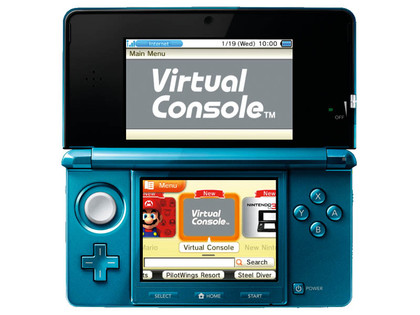
The core of the DS remained the same though; a book-like, dual-screen handheld with the touch functionality that augments the gaming experience with an extra dimension of interactivity that spawned the DS success in the beginning.
But now, with the release of the Nintendo 3DS, Ninty is having a punt at revolutionising video games for a third time and 'extra dimension' is the key phrase again.
The 3DS originally launched for well over £200 – closing in on £300 in many stores. But after poor sales, Nintendo has slashed the price drastically, and the console can now be picked up for a little over £110.

At first glance it looks like a shinier, sleeker version of its brothers and it still has the same dual-screen, touch sensitive set up. This time, however, the top screen boasts the ability to beam your gaming experience in full auto-stereoscopic 3D - that's 3D without the need for a pair of 3D specs.

Ok, so the likes of Avatar have already reignited the 3D interest for cinema and Sony's pushing 3D gaming on the PS3 – pricey TVs and cumbersome glasses included – but unassisted, palm of your hand 3D is a completely different and massively exciting prospect.
The Nintendo 3DS has the potential to be a massive stride forward from its predecessors and another landmark product that Nintendo can lay claim to. If it works, that is. We've been working on our Nintendo 3DS review for the last week - here's the verdict...
- Best Nintendo 3DS games: 20 fantastic titles you can take on the go

To look at the, the Nintendo 3DS is more or less classic DS design.
It's slightly smaller than the DSi in terms of sheer size, at approximately 135mm x 74mm but is a bit thicker at 20mm deep compared to the DSi (137mm x 75mm x 19mm) and weighs around 8 ounces with battery, stylus and SD card on board.
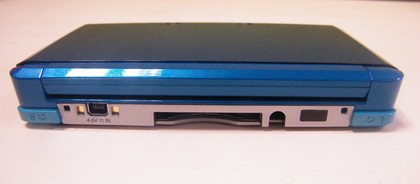
It looks that bit sleeker though, with curved corners, angled edges and shiny gloss finish. This time the lid houses two cameras rather than one (necessary for the 3D camera we'll come on to), both placed centrally at the top of the panel, and each about half the size of the DSi's camera.
Placed at the back on either hinge, as with the DSi, are the two shoulder buttons which look slightly smaller this time in that they don't protrude quite so much as on the last model. The hinges themselves carry on the gradual lines of the device to complete the look.
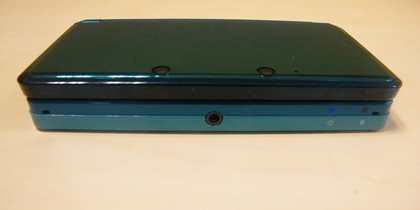
Lift the lid on the 3DS and the more sophisticated design ethos is continued with a black, gloss finish border that makes up the front face of the 3DS and surrounds the top screen. It's a neat departure from the single colour-scheme we're used to.
In terms of how the new device is to hold, the 3DS doesn't feel quite so expensive or solid as something like the Sony PSP. The d-pad, face and shoulder buttons are small with that distinctly 'clicky' feel. We'd also say that when fully open, the top panel encroaches on the space your fingers need around the shoulder buttons. A minor quibble that's only noticed every now and then, and who's to say we don't have chubby fingers?


Where the 3DS does trump the PSP in terms of control, however, is with its new analogue nub – officially called the Circle Pad. The point of analogue control has obviously been a tough nut to crack for designers of portable games consoles recently.
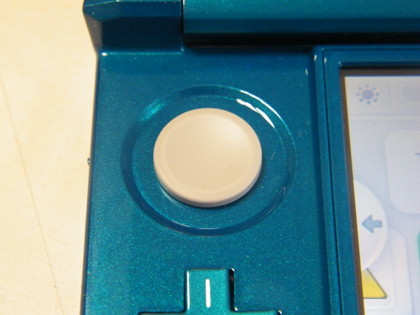
Sony's current handheld has a flat nub with imprinted grip, something that has been criticised for being difficult to manoeuvre because of its flat design that sees players slide their thumb around awkwardly rather than pushing and pulling as they would with a stick.

Having gone down the nub route as well, Nintendo's Circle Pad is still a bit of a chore to push around compared to a proper stick as well and Sony's NGP will likely take the analogue control crown when it releases with two full-on sticks.
What does help the Nintendo 3DS, however is the fact that the Circle Pad has a concave surface. The shallow banks of the nub act as a nest for your thumb and mean that you have at least something to push and pull against to an extent without slipping off.

The Circle Pad was responsive with a quick snap back to the centre once it was released. We had a couple of handhelds to play with, however, and one demonstrated a particularly sticky Pad which didn't come all the way back to the middle if it was pushed to its boundaries
Since this was just one case, though, we have to give the 3DS the benefit of the doubt, although it does make us wonder whether the nub design could be prone to stickiness over time.
Also of note the placement of the front facing camera, now above the screen rather than on the join between the panels and the addition of three new buttons (Home, Start and Select) under the bottom screen.

Getting onto the technology that drives the 3DS, that lower screen is LCD with the resistive touch capabilities that can be controlled with the included, 4mm, extendible stylus your finger. It measures 3.02 inches and has a 320 x 240 resolution.
The top screen is the important one though. It makes use of lenticular lens technology to create the final 3D image. Simply put, the screen uses a series of long thin lenses called lenticules that have cured fronts.

Because of their shape the lenticules direct the pixels' light in different directions and each eye sees an alternate column of pixels. You can probably fill in the rest: Two images are rendered by the 3DS' GPU, they are sent to separate eyes by the lenticules and, as you probably know, by seeing two slightly separated versions of the same image we get glorious 3D.
Of course, to look as good as the current Nintendo DSi, the 3DS needs to have twice the resolution, and it has exactly that and then some.
Where the DSi screen ran at a resolution of 256 x 192 This time we're treated to a 3.53 inch wide-screen LCD display zapping 16.77 million colours in what Nintendo's calling 800 x 240 pixel resolution (what it actually means is you get 400 x 240 in each eye and then the same in both eyes when in 2D mode). Not only does the 3DS present you with unassisted 3D then, it's bested its predecessors significantly in terms of resolution in the 2D arena as well.

PAPER: The 3DS comes with a wad-like and not-exactly-environmentally-friendly multi-lingual user guide
What's driving the 3D machine hasn't actually been officially disclosed and without being able to take the console to pieces just yet we have to rely on reports that the handheld contains a twin ARM11 266 MHz processor and the PICA200 GPU from Digital Media Professionals.
Also reported is 1.5GB of flash storage, 63MB of RAM (although some contesting reports suggest 96MB) and 4MB of dedicated video memory. Also tucked away inside the body is a motion-sensor and Gyroscope, which will come into play later.
All this is powered by a battery that Nintendo has estimated will offer 3 – 5 hours of life and longer when playing games from the DS back-catalogue using the 3DS' backwards compatibility.
Not too different to the DSi then, although after putting the 3DS through its paces it seems that the avid amongst us will only hit the minimum estimation - we were out of juice at three hours of constant play in full 3D. Nintendo does, however, provide a nice little charging cradle as part of the package and the handheld had no problem lasting the day when in sleep mode.
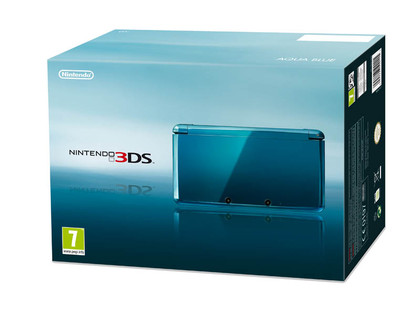
The 3D effect that's conjured as a result has a focus on depth rather than throwing objects out of the screen at you all the time. How much depth exactly depends on the design of the game itself and player discretion. A slider on the side of the top panels allows gamers to adjust the level of depth, acting almost as a visual volume button.
The slider will probably be used in varying amounts as people take to 3D differently. We had the effect on maximum for the most part though and found the effect to be sharp, deep and with very little ghosting when we had the 3DS positioned in a way that hit the 'sweet spot'.

And the sweet spot is crucial. You need to hold the 3DS so that it's central, still and head on if you want the best effect. It's by no means hard to find the right angle, it's the one you'd most naturally adopt, but movement does interfere with the picture significantly.
The amount of forgiveness you get for straying depends on how 3D your image is in the first place. If the images are split to a greater extent to give the impression of more depth, the difference will be more apparent once you start to angle the screen in such a way that makes one image more prominent than the other.
The games we played
We were able to get our hands on two games; Nintendogs + Cats and Super Street Fighter IV: 3D Edition. Nintendogs + Cats boasted the greater amount of depth and so even a degree of sideways rotation of the 3DS caused flickering of the image and the occasional split-second blackout. Titling the handheld forwards and backwards doesn't have the same amount of visual degradation, though.
Street Fighter could take more movement in all directions before the image started to ghost significantly. There was generally less depth in Street Fighter, though, since the focus is on two players – there's no gameplay element that requires roaming in and out of the foreground so the background plays an aesthetic role.
But there are two camera angles in the 3D Edition of Street Fighter - the traditional side-on view is 3D only in the sense of having different layers of 2D cell-shaded art stacked on top of each other.
A second camera angle, however, rotates the side-view around so that it's more a diagonal over-the-shoulder shot and this is the angle at which to get the best 3D effect. The characters become full 3D models and the sense of depth is much more obvious and complete as objects in the background have depth to them as well as looking further away.
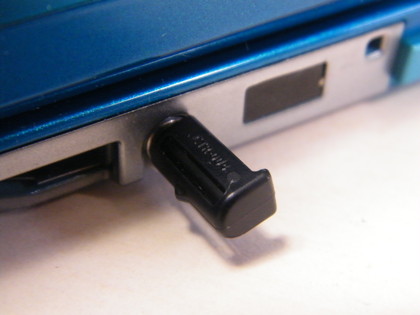
There're also some examples of protruding pixels here as well; because of the angle, the outside of your character's body – particularly the elbow, for example, as certain punches are thrown – noticeably occupy the foreground in comparison to your opponent who appears in the background.
The best example of a 3D image coming out of the screen we witnessed, however, was during Nintendogs + Cats, when our kitten came right up to the screen and then poked its head clearly beyond the glass.
In both cases though, like we've said, the 3D effect is more one of depth. When we're considering how much more immersive the gaming experience becomes, it doesn't work in the sense of surrounding your head and making you feel like you're actually sitting in the game, but it does make you feel like you could stick your hand into the world and touch everything.
It also enhances the graphics, not necessarily in a technical sense of quality, just in the way objects look more realistic and solid because of their added depth.
It was when our cat pushed its head right out of the screen that we started to really appreciate the extra graphical quality the 3DS has over previous iterations, regardless of the 3D wow factor. The graphics in Nintendogs & Cats are far more detailed than previous versions, showing off the extra power and resolution of the 3DS.
Using the 3D slider to turn off the effect, there wasn't too much difference in visual quality when playing both games in 2D. The lines in the backgrounds of both games became sharper in 2D but only negligibly, there a more noticeable dulling in colour with 3D mode activated though.
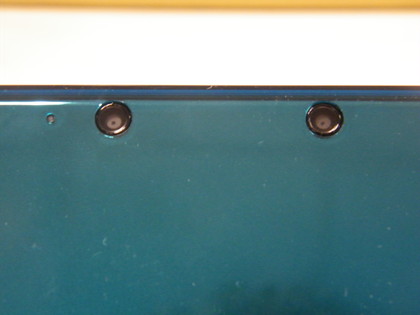
Outside of its gaming capabilities, the 3DS tech is also used for a 3D camera with a 640 x 480 resolution and an active pixel count of around 300,000. The photos that come out of the other end are good for a bit of pointing and cooing but we found them to be a bit grainy and the 3D effect is actually a case of have 2D images layered on a 3D plain.
For the core Nintendo audience, this will be more than impressive and a nice gimmick, but after playing 3D games that use the tech so well we couldn't help but be a bit disappointed by the camera.
Another trick in the 3DS repertoire is its augmented reality, which makes use of both the camera and the on-board gyroscope. Face Raiders, for example, is a small first person, sci-fi blaster that sees you move the 3DS around to target enemies in a similar way to GunRange for the iPhone 4.
When you miss an enemy and shoot the backdrop it breaks away, sending debris floating towards you and revealing the view from the camera.
It's a simple game but it does seem like a bit of an error of judgement since moving the 3DS around so vigorously means that you'll inevitably lose that sweet spot at some point. The 3D usage in Face Raiders, however, is comparatively less than what we've seen in the full games, with not too much moving in and out of the foreground, which is probably a good thing for the above reason.

There's also a group of more specific augmented reality games that make much more use of the tech. They're activated by putting a yellow card on a clear surface like a desk and pointing the 3DS camera at it. The best of the bunch sees the card turn into a tree covered island before your eyes giving you the task of finding and shooting a number of targets.
By moving the 3DS around the scene as if it were actually there you can look around trees, behind objects and even down holes that are two deep for your desk to accommodate in order to find the targets.
A lot of the other AR features are probably better described as tech demos more than anything, they're there to look impressive but don't actually do much. 'Star pics' is especially guilty of this; it uses separate cards with famous Nintendo faces on them which spawn statues of Link, Kirby, Mario and Samus depending on which dedicated card you put in front of the camera.
Once they're standing on your desk you can change their size, pose or glide them slowly along the table. There's nothing more to them than that, but hopefully they'll be the start of something much bigger.
There's a social element to the 3DS' as well in the Street Pass system. This automatically exchanges things like high-scores and custom characters which other 3DS portables in close proximity.
It also tries to encourage gamers to use the system and keep their 3DS active in sleep mode at least by rewarding them with a piece to a jigsaw puzzle for every new person (and their virtual Mii avatar), more interestingly, a piece to a jigsaw puzzle or XP for a basic RPG action game centred around your Mii.
The 3DS could pick up our fellow users the second we walked into the office, so it seems sharp in terms of connectivity there. The related mini-games are overly simple but will be enjoyed by gamers with a gotta catch 'em all mentality. Besides, it's more a way for Nintendo to keep 3DS consoles active so that they can automatically grab updates and software from the net using the Spot Pass system over WiFi.

While 3D gaming still splits opinion, this is a relatively cheap, accessible way to enjoy it and the quality is more than good enough to offer an impressive and immersive experience.
We liked:
The revelation that is glasses-free 3D visuals in a handheld device. More to point, the fact that it works so well. Okay, there's a definite sweet spot that you need to maintain if you want that 3D image to remain sharp but it's not really that hard to work it out.
Couple this with the extra power and resolution that the 3DS has over its closest ancestor and there's a much better graphical showcase on offer for 2D lovers as well, which is why we can expect bigger and better looking games than what's been possible on the DS to date.
The new price is very attractive, too.
We disliked:
The camera. For us it fails to be much more than a gimmick. Perhaps we're coming from a hyper-critical perspective and may fall just outside of the audience Ninty is hoping the camera will please but, with its slightly grainy quality and 2D layering, it's little more than a toy to us. A good chunk of people will be pleased with it for that reason though.
We're not completely taken with the application of the augmented reality tech either, especially the Star pics feature which has little more than slightly movable statues of Nintendo greats to offer. However, if there's any company we feel we can trust to take the foundations of what feels more like a tech demo and turn it into something great, it's Nintendo.
Verdict:
The 3DS outdoes its predecessors significantly when it comes to power and visual output, which means Ninty players can look forward to demanding names like Resident Evil and Metal Gear Solid in the future.
This is a device that's going to grab everyone all over again but, at the same time, it's got plenty to offer the gaming hardcore as well and that's just as big a step forward as the specless 3D visuals.
0 comments:
Post a Comment